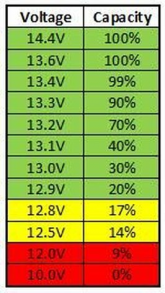So it's 3am here, hopefully I make sense when I type this out. We just switched to lifop4 a few days ago, and we've been thrilled so far. But around 2:30 this morning I woke up to the inverter screaming (we're off-grid, the cabin is powered by batteries). The battery is at 10.0!
Hopefully I have the BMS wired correctly. It came with no diagram and the seller wouldn't give me specs on it. The listing was titled "Daly LiFePo4 4S BMS 12 V 200 400 A" though the unit doesn't say Daly on it. It looks impressive and well built. Anyway, I have the B- cable to the main battery negative, and the P- cable my main system ground. I have the black cable on the BMS clip to cell1-. It's the same terminal that B- is on. Okay. Then red1 to cell1+. red2 to cell2+, etc for the 4 cells. I attempted to follow a chart like this:
and as far as I can tell it's wired properly. I have nothing else connected to my negative terminal.
We had a grey snowy day and the battery was at a not-so-happy 12.1 when we shut down for the night. Figured we'd charge it back up in the morning.
So I have 2 problems I suppose. 1 being that we seem to have had a parasitic draw. I actually turned off the inverter when I woke up to this, and in the 5 minutes it took me to get the multimeter out the battery was back up to 10.26. After about 45-60 minutes it was up to 10.8. So I need to figure out why the inverter was drawing power with nothing plugged into it. I've been using this inverter for 5+ years and have never had a problem. And it hasn't had a problem the last few nights of the new lithium system. The battery has held voltage perfectly overnight so far. I normally just unplug the house from the inverter so nothing is drawing AC power (versus turning the inverter off). ANYWAY. Problem 2 being that the BMS didn't stop that parasitic draw from draining the batteries.
But why didn't the BMS shut the power off to the system? Am I mistaken in how they're supposed to work? If I haven't mussed up my wiring, is there a way I can test the BMS before contacting the seller? I'd really rather hope that I wired it wrong, I'd rather this be my fault.
Hope this makes sense. I'm not human at 3am.
I've got my battery charging now while I do some research, which is probably futile when I'm this tired.
Hopefully I have the BMS wired correctly. It came with no diagram and the seller wouldn't give me specs on it. The listing was titled "Daly LiFePo4 4S BMS 12 V 200 400 A" though the unit doesn't say Daly on it. It looks impressive and well built. Anyway, I have the B- cable to the main battery negative, and the P- cable my main system ground. I have the black cable on the BMS clip to cell1-. It's the same terminal that B- is on. Okay. Then red1 to cell1+. red2 to cell2+, etc for the 4 cells. I attempted to follow a chart like this:
and as far as I can tell it's wired properly. I have nothing else connected to my negative terminal.
We had a grey snowy day and the battery was at a not-so-happy 12.1 when we shut down for the night. Figured we'd charge it back up in the morning.
So I have 2 problems I suppose. 1 being that we seem to have had a parasitic draw. I actually turned off the inverter when I woke up to this, and in the 5 minutes it took me to get the multimeter out the battery was back up to 10.26. After about 45-60 minutes it was up to 10.8. So I need to figure out why the inverter was drawing power with nothing plugged into it. I've been using this inverter for 5+ years and have never had a problem. And it hasn't had a problem the last few nights of the new lithium system. The battery has held voltage perfectly overnight so far. I normally just unplug the house from the inverter so nothing is drawing AC power (versus turning the inverter off). ANYWAY. Problem 2 being that the BMS didn't stop that parasitic draw from draining the batteries.
But why didn't the BMS shut the power off to the system? Am I mistaken in how they're supposed to work? If I haven't mussed up my wiring, is there a way I can test the BMS before contacting the seller? I'd really rather hope that I wired it wrong, I'd rather this be my fault.
Hope this makes sense. I'm not human at 3am.
I've got my battery charging now while I do some research, which is probably futile when I'm this tired.





